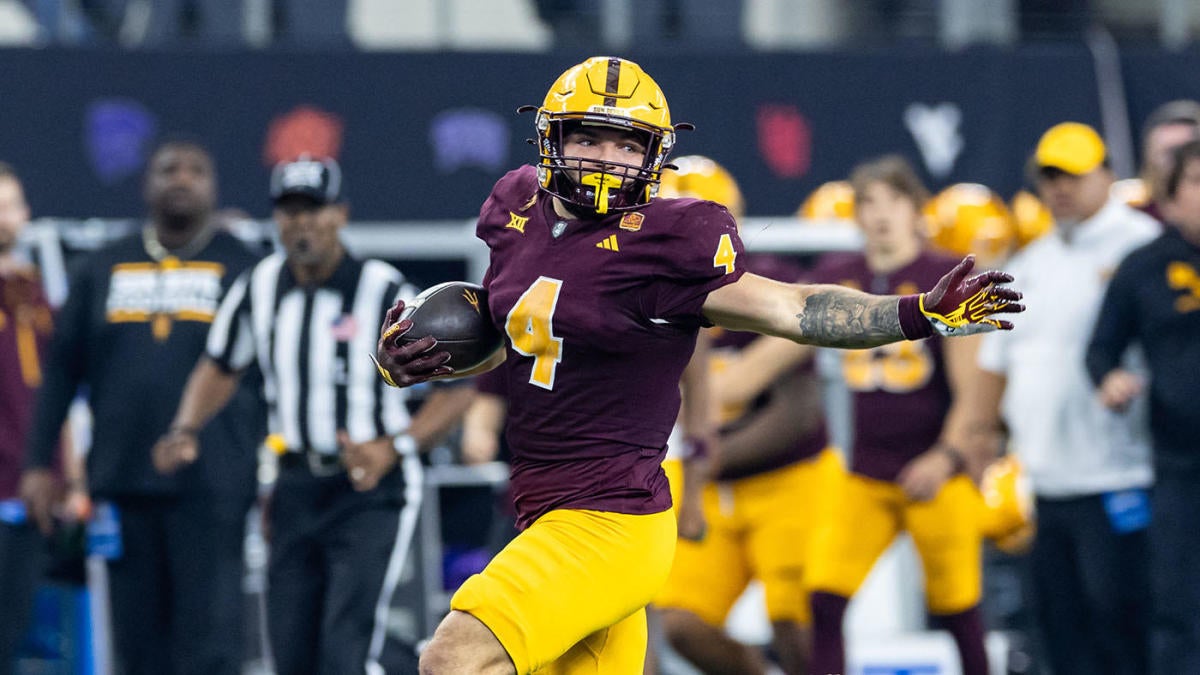Sports
KU Sports

AP Photo/Sam Hodde
The color guard rehearses on the field before the First Responder Bowl NCAA college football game between Utah State and Memphis, Tuesday, Dec. 27, 2022, in Dallas.
The Kansas football program has one major hurdle to clear if it wants to reach a third straight bowl game for the first time ever: beating a streaking Baylor team in a stadium where the Jayhawks have never won.
If they do that, it’s anyone’s guess what the month of December might hold.
Due to the new 12-team College Football Playoff format, a possible excess of bowl-eligible teams and a relatively low number of games with Big 12-specific tie-ins — two of which the Jayhawks have already been selected for in recent years — a 6-6 KU team could find itself playing in any number of locations at any number of times.
In fact, the Jayhawks could even be left out of the postseason altogether in a couple different ways.
How they could be left out if they win at Baylor: There are 35 non-playoff FBS bowl games, so 70 teams, plus 12 more teams that go to the playoff, meaning a possible 82 postseason spots for bowl-eligible programs. Already, 77 teams have reached the six-win threshold. Among the 16 current five-win teams, Virginia and Virginia Tech play each other, as do Eastern Michigan and Western Michigan, meaning 79 are guaranteed to reach bowl eligibility. That means as many as nine of the 12 remaining teams could have six wins and still get left without places to play in the postseason.
Granted, a 6-6 KU squad entering the postseason on a four-game winning streak with a large fan base and a fair amount of national attention would seemingly be a pretty appealing pick for a lot of bowl committees, so maybe the Jayhawks wouldn’t find themselves on the chopping block in such a scenario.
How they could be left out if they lose: This might be a bit more obvious; that said, teams with 5-7 records have occasionally been known to earn bowl berths in case of a shortage of bowl-eligible options (which hasn’t been rare at all in recent years). For the reasons above, that doesn’t seem particularly likely this year. Even if, say, all 12 additional teams lose and there are three empty spots remaining, the three teams to fill those will likely be selected based on the NCAA’s Academic Progress Rate (APR) metric as they have in years past, and in the most recent APR data available online on the NCAA website, KU comes in lower than most of the teams it would be measured against.
Assuming KU makes some sort of bowl
As a result of its recent run of success, KU has started to appear in bowl projections assembled by national college football experts, even though it still has to emerge from a game in which it is narrowly expected to win — after Baylor opened as the favorite — in order to become an option in the first place. From a sample size of nine projectors, two, Erick Smith of USA Today and Steven Lassan of Athlon Sports, perhaps feeling some uncertainty about this result, omitted KU altogether.
The rest have the Jayhawks in all sorts of places: two in the Birmingham Bowl, two in the Independence Bowl, one in the First Responder Bowl, one in the Frisco Bowl and one in the Rate Bowl.
The first thing you may notice, if you’ve followed these sorts of things over the years, is that some of these are not even bowl games with specific Big 12 tie-ins.
That’s likely because the Big 12 already has nine bowl-eligible teams and could get as many as two more if KU and Cincinnati both win this weekend (the Bearcats face TCU). On its 2024-25 bowl selection process website, the Big 12 lists seven possible spots, plus additional opportunities to play in “ESPN Events Pool Games,” for its longtime teams.
Its four recent additions from the Pac-12, for the record, have their own set of six possible games, which they share with their former leaguemates who have scattered to the four winds. Two of the Big 12’s bowl-eligible teams, Arizona State and Colorado, are former Pac-12 members.
That means that if KU and Cincinnati enter the picture, as many as nine teams could be earmarked for seven Big 12 spots, which might consign the lower-ranked candidates among them to the mysterious ESPN Events games.
The consensus among bowl projectors such as Action Network’s Brett McMurphy and The Athletic’s Scott Dochterman and Stewart Mandel seems to be that ESPN Events — the division of ESPN that owns and operates a total of 16 FBS bowl games — can move teams between its various contests however it chooses. That is presumably why McMurphy and Bill Bender of The Sporting News have KU in the ESPN-owned Alabama-based Birmingham Bowl against Oklahoma and Vanderbilt, respectively, and CBS Sports’ Jerry Palm pits the Jayhawks against OU in the Frisco Bowl in Texas, even though neither game has in recent years boasted an explicitly stated Big 12 affiliation.
Mark Schlabach of ESPN has KU in a game with a known Big 12 tie-in, the Dallas-area First Responder Bowl against Memphis. Brad Crawford of 247Sports also chose a standard Big 12 bowl by putting the Jayhawks in the Rate Bowl — however, its snappy new name belies the fact that it is the very same Guaranteed Rate Bowl in which KU played UNLV last year. (His proposed opponent this time is Rutgers.) That recent selection, as well as the fact that KU went to the Liberty Bowl in 2022, would seem to eliminate the Jayhawks from consideration for two of the Big 12’s lower-level berths — which presents an added projection challenge.
That could explain why Dochterman and Mandel, as well as ESPN’s Kyle Bonagura, placed KU in the Shreveport, Louisiana-based Independence Bowl (against Army and Louisiana, respectively). This game was a straightforward Big 12 tie-in last year; the league sent Texas Tech. Now, it is part of the pool for former Pac-12 teams.
However, it’s not clear whether there would even be space for KU in this game, if it were an option; remember, there are six former Pac-12 bowl tie-ins for the likes of not just Arizona State and Colorado but Oregon, USC, Washington, Washington State, etc. There could be another excess of eligible teams, though top-ranked Oregon is a lock for the CFP and ASU or CU could make it by winning the Big 12 title.
All this guesswork, with minimal clarity, presents a stark contrast as compared to last season, when with one week to go in the regular season the then-Guaranteed Rate Bowl was a pretty clear favorite to serve as KU’s postseason destination.
Of course, even then, it came as a surprise that the Jayhawks got matched up against UNLV and not a Big Ten Conference team as had been expected — demonstrating the sheer unpredictability of college football’s postseason.

PREV POST
Big 12 power rankings: ASU gets its turn as No. 1 entering final week of regular season
NEXT POST
Puzzling through postseason prospects if KU beats Baylor












